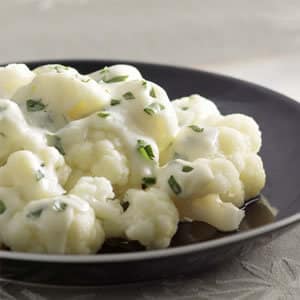Cauliflower Power – Healthy Cauliflower Recipes

Alpa Momaya
March 26, 2021

Alpa Momaya
March 26, 2021
Jasminder Nagra may have scoffed at aloo gobhi as she tried to Bend it Like Beckham but her mum seems to have known more than she let on. The humble cruciferous cousin of broccoli, kale and kohlrabi has a lot going for it.
Loaded with vitamins, minerals and cancer-fighting phytochemicals, the cauliflower is a powerhouse of nutrition. Extremely low in calories, it’s now edging out broccoli as the hot new superfood on menus worldwide.
No wonder health-conscious mothers in the US and Europe are coaxing their children to “eat your cauliflower” instead of “eat your greens”. Fine dining restaurants have also moved the vegetable from the side dish menu to the main course one. Cauliflower steak, anyone?
The cauliflower craze runs so deep that the vegetable is being used as a base for many food items. Supermarkets abroad sell cauli-couscous, pizza base or flour (cauliflour, if you wish). Cauliflower rice, made by grating the florets, is a rage as a low-calorie replacement for rice – it contains only 25 calories per 100g compared with about 140 calories per 100g of cooked white rice.
One of the chief reasons for cauliflower’s new-found popularity is its cancer-fighting potential. Cauliflower contains sulforaphane, a compound that reportedly has an adverse effect on cancer cells. A regular intake of cauliflower has also been linked to reduction in risk of cancers affecting the breast, bladder, colorectal region and lung. A recent study also found that combining cauliflower with curcumin – a compound in turmeric – can cure prostate cancer.
That’s not all. The good old gobhi is also anti-inflammatory and promotes heart health, brain function and digestion. Eating cauliflower daily would give you an assured supply of fibre, folate, calcium and vitamins A and C. One portion of cauliflower contains 77 per cent of the recommended daily quota of vitamin C.
Broccoli, which enjoyed superfood status for years, also offers similar benefits but cauliflower’s calorie count has made its star shine brighter. A cup of cauliflower contains just 28 calories and 5 grams of carbohydrates. The same quantity of broccoli gives you 48 calories and 8 grams of carbs. The cauliflower is available at local sabzi thelas through the year and at a cheaper rate.
Forget the gobhi pakoras and give these healthy cauliflower recipes a shot:

2 cups cauliflower florets, 3/4th cup curd, 1 teaspoon ginger paste, ½ teaspoon crushed green chilli, 1 teaspoon olive oil, salt, turmeric, red chilli powder, garam masala, cumin seed powder and coriander powder, to taste
Mix ginger paste, crushed chillies and the spices with curd in a big bowl.
Put cauliflower florets in the batter and leave to marinate for ten minutes.
Lightly grease a baking dish with olive oil, lay the florets on it and roast in oven for 15 minutes.
Serve with coriander chutney.

1 cup cauliflower florets, 2 cups skimmed milk, 1 tablespoon wheat flour, 2 teaspoons olive oil, 1 teaspoon garlic paste, salt, pepper and oregano (optional)
Steam the cauliflower using a sieve and leave the pieces to cool down.
Heat the oil in a pan. Add garlic and sauté for a few seconds. Put in the wheat flour and keep stirring till golden brown.
Pour the milk and stir for a few minutes on low flame to avoid forming lumps while it thickens.
Add cauliflower, salt and pepper. Continue cooking for a few more minutes.
Serve with whole wheat garlic toast and chilli sauce.

